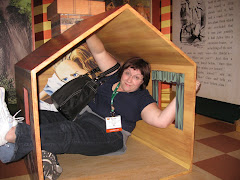With internship complete and summer barreling along toward fall, I have been neglecting my blog (mostly due to the insane amount of time spent on Facebook lately). My thought was always to continue it as a place to talk about museums, education and life in general. Not that I assume that I have any sort of audience, but a girl can pretend, yes?
Reading through today's Google Alerts, I stumbled upon Stephanie Weaver's blog. Weaver is the author of "Creating Great Visitor Experiences." It's an easy read, and should be required for anyone in museums. Some of the advice is pretty standard, but then again, after 6 years as a front line manager plus time in retail and food service, I've had just about every customer service training in the book.
Weaver's blog is really nice! I plan to spend some dedicated time reading the archives, particularly the "Sunday Signpost"...er...posts. I am not a graphic designer, but in my capacity as project manager, I have become quite enamored of signs and graphic/text panels. When well done, they are amazing. When not, they are....not.
One particular post caught my eye. Weaver shares a simple dry-erase style sign from an airport, and makes the comment that it "tells [her] that they care about the customer experience." What a fascinating concept! And I mean that without sarcasm. In some museums, a handwritten sign would never be used. I can be seen as unprofessional, sloppy and careless. However, as pointed out by Seth Godin, sometimes a handmade sign can be more effective. It draws the eye by virtue of its imperfection. Humans respond to humanity - and while a gorgeous graphic layout can be wonderful, sometimes a simple sign is best.
So, what's a creative designer to do? If you aren't allowed to make a handmade sign, how do you get the point across? Here at TCM we recently used a professional sign, made to look like a Post-It note, with a scriptlike font. It gives the feel of handmade, but without actually being handmade. Does this satisfy the need for the "human element" in signs?
And what about the customer service angle? The reason a handmade sign gives good customer service is that it says, with little fanfare, that you care enough to change courses and respond immediately to them. Handmade signs are not generally a long term solution in museums, but are ideal for quick communication about exhibit programs, special events, closings, etc.
In what other ways can we use "human" created elements? Or things that appear to be handmade? How will those elements change our design? How will they change the way visitors use the exhibit?
Monday, July 14, 2008
Subscribe to:
Post Comments (Atom)

2 comments:
Hi Sarah,
Thanks for the link to my blog! I, too, have been neglecting my blog of late.
I agree that, usually, hand-written signs are a symptom of a problem, as staff people get tired of waiting for someone else to fix a problem and make their own sign to deal with it. But in that particular case at the airport, I truly felt that the baggage claim people cared about us.
Best,
Stephanie Weaver
Stephanie, I really enjoyed your blog! I like the hand-written idea when it comes to showing visitors that you will respond immediately to concerns. Thanks for stopping by!
Sarah
Post a Comment